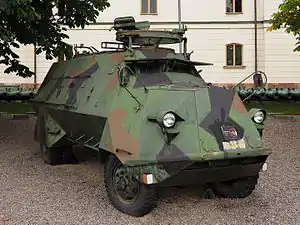KP-bil
Terrängbil m/42 KP (Tgbil m/42 SKP/VKP), meaning "Off-road vehicle model/[19]42" with a secondary designation of "Scania, Bodywork: Armoured" or "Volvo, Bodywork: Armoured", was the Swedish army's first armoured personnel carrier, developed as a stop-gap measure during World War II.
| Terrängbil m/42D SKP | |
|---|---|
 Last version of the tgb m/42 D SKPF at the Swedish Army Museum in Stockholm. | |
| Type | Armoured personnel carrier |
| Place of origin | |
| Specifications | |
| Mass | 8 500 kg |
| Length | 6.30 m |
| Width | 2.30 m |
| Crew | 3 (commander, driver, gunner) + 7 fully equipped soldiers |
| Armor | Mostly 8 mm, but variable between 4-20 mm. |
Main armament | dual-mounted ksp m/36 (8x63mm dbl lv), last version dual-mounted KSP 58 |
Secondary armament | Smoke dischargers x6 |
| Engine | Petrol/Motyl, 4-cyl Scania-Vabis 402/1 115 hp (85 kW) at 2300 rpm |
| Power/weight | 300 km |
History
In 1941, when tanks were organised into a unit of their own, it was clear there was a desperate need for a troop carrier able to both keep up with the tanks and provide protection against artillery shrapnel and small-arms fire. Due to the war there were no international suppliers to buy from, so the only option was to develop a domestic solution. AB Landsverk designed an APC consisting of a chassis from a regular army lorry equipped with an armoured shell.
The armour-plates were made by Bofors, Landsverk, Bröderna Hedlund and Karlstads Mekaniska Werkstad and then delivered to Volvo or Scania-Vabis for final assembly on their chassis'. The Volvo versions, Tgb m/42 VKP had a fixed {{winch]] on the right side for towing the vehicle forward, while the Scania-Vabis, SKP, instead had a windlass on the left side which allowed towing both forwards and backwards. The first approved delivery was made in 1944, after some 38 vehicles had been failed due to tensions caused by welding the hardened steel. This was rectified by switching to a soft-hardened steel and then heating the completed body-work in purpose-built ovens to remove the tensions.
During the 1950s the vehicles were modified with a ring-mounting for a double machine gun on the cab roof and at that time the designations changed to Tgb m/42 VKPF and SKPF (F = Fordonsluftvärn, or vehicular anti-aircraft).
The SKPF saw combat with Swedish UN forces during the Congo Crisis in the 1961-1964 period, while the VKPF was kept for domestic use. 15 SKPFs were also bought by the UN and used by the Indian and Irish battalions in Congo. After a number of KP gunners in Congo were shot in the waist, armour plating to cover the gap between the roof and the machine gun ring was added in sito. A few left-behind UN SKPFs were reconditioned and used by the Congolese Army in 1964-65. SKPFs were also deployed by United Nations Peacekeeping Force in Cyprus during the intercommunal violence in 1964.[1]
In the 1980s and 1990s, many surviving SKPFs of the Swedish Army were modified with armoured roofs and in many other ways, resulting in several new versions.
See also
| Wikimedia Commons has media related to Tgbil m/42. |